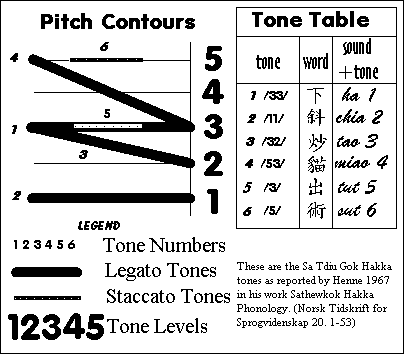
The SaTdiuGok Hakka Tonal System's Pitch Contours
Click here for a Real Audio playback of the examples given in the table above.
I have looked around the internet for a discussion of this, but there just seems to be a blank. So here is my go at it. I am not a linguist and so I shall do my best to define the words that I will be using. It will be a 'make it up as I go along'-page, so don't hold your breath. (Updated to include SL Lee's suggestions.)
> Your did not put the tone value in your spelling. It is not very difficult to count. > For example, the first to sixth tone in my accent is represented by: > > fun1 (divide), fun2 (grave), fun3 (powder), fun4 (portion), fud5 (hole in the ground), > fud6 (budda)
In Hashimoto's book "The Hakka Dialect", he gives a treatment on the tonal systems through the use of pitch contours of a number of Hakka Dialects. The Shataukok dialect pitch contours are listed as (1: /33/) (2: /11/) (3: /32/) (4: /53/) (5: /3/) (6: /5/). His source is Henry Henne, Sathewkok Hakka Phonology, Norsk Tidskrift for Sprogvidenskap 10. p. 1-53. 1964.

The Moi Yen tone contours are as follows. (1: /33/)(2: /11/)(3: /31/)(4: /55/)(5: /31/)(6: /44/). The tones 5 and 6 are underlined to distinguish them from the other contour values.
Tradtionally the tone number represents
| Tone | Character | Hakka | Description of Tone | Tone Contours | Examples of Homotonic Characters and their sounds in Sa Tdiu Gok Hakka Click below for sound samples | ||
|---|---|---|---|---|---|---|---|
| SaTdiuGok | MoiYen | ||||||
| 1 |  | yin pin sang | l e g a t o | mid level | /33/ | /33/ |  ma jiam on sang |
| 2 |  | yong pin sang | low level | /11/ | /11/ |  ma zam van miang | |
| 3 |  | song sang | mid falling | /32/ | /31/ |  ba tam pin giang | |
| 4 |  | hi sang | high level | /53/ | /55/ |  sa am mun ngang | |
| 5 |  | yin ngip sang | s t a c c a t o | mid falling | /3/ | /31/ |  gap git gok |
| 6 |  | yong ngip sang | high rising | /5/ | /44/ |  hap sit hok | |
It is surprising therefore for there to be four legato and two staccato tones. If we substitute the words long sound and short sound for legato and staccato respectively, we realise that the only way a sound can stay long (in the time to speak it), is that it must end in a vowel, or consonant with heavy off glide, or 'humming' of the sound. Similarly, for there to be a short sound, it must be brought to a sudden halt by a consonant.
The latter point is served when we examine the word lists of the short low tone 5, and of the short high tone 6. After surveying Hashimoto's word lists, I have observed that the words ending in consonants 't', 'k', and 'p', with their counterparts 'd', 'g' and 'p' are usually tone 5 or 6. Hashimoto's phonological treatment is given in pages 90 to 95.
So far we have concentrated on the two short tones. Of the other legato or long tones, the Moi Yen dialect has tone 3 simialr in pronunciation to tone 5. In fact this is reflected in Hashimoto. I was puzzled for a while why this was so, since he adopts two tone marking systems; one, a numerical system as described above, and the other a graphical system of angle lines to a vertical stem. He had only five unique graphical tone markers. On reviewing his work again, we realise that the pitch contours he used for the Moi Yen dialect has the same tone level vales in tones 3 and 5. In the Chung Shan dialect, (1: /24/)(2: /11/)(3: /42/)(4: /55/)(5: /1/)(6: /5/), the staccato tones 5 and 6 mirrors tones 2 and 4 respectively, giving the appearance of four basic tones. In my own Shataukok dialect, tone 5 near-mirrors that of tone 3 instead of tone 2. Tone 6 near matches that of tone 4. (With staccato, the abrupt stop produces one level, whilst in legato, sounds are elongated slightly bring the tone level down a level).
Below are the Real Audio files (each approximately 3K in size best with at least a 28.8kbps modem) of the four legato and two staccato tones. Please click on the underlines tones to hear fun 1 to 4 and fud 5 and 6. (see earlier). If you do not have a Real Audio player, you may aquire a free download from their site at http://www.real.com/. In descendency of pitch the highest legato tone would be tone 4, then tone 1 , tone 3 and tone 2 respectively.
You may like to compare the following tones tone 5 : tone 3 and tone 6 : tone 4.
This page was first created on Wednesday 24th September 1997.
and then updated Thursday 25th September 1997 and again
to include homotonic characters on Tuesday 27th January 1998.
You can E-Mail me on anything within these pages.